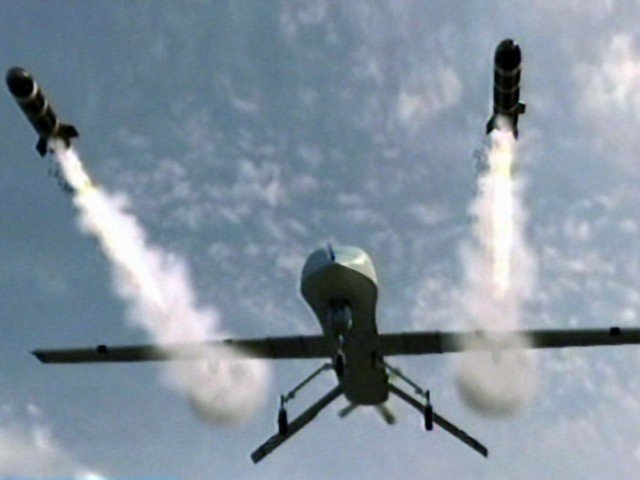
Drone Warfare: Killing By Remote Control
Medea Benjamin
Verso, 2013
246 pages, $24.95(pb)
“Never before in the history of warfare,” boasted the Wall Street Journal, “have we been able to distinguish as well between combatants and civilians as we can with drones”.
The Obama administration has helped in this claim, writes Medea Benjamin in her book on the “unmanned aerial vehicle”, by conveniently defining every military-age male in a drone strike zone as a “combatant”.
The 60% domestic support that drones enjoy in the US rests largely on the reputation of the drone as “the cost-free magic wand that can eliminate terror”.
“Don’t you want the bad guys to die?” is the argument used to silence doubters as drone killings of Taliban and Al Qaeda leaders in Afghanistan, Pakistan, Yemen, Somalia and north Africa comes with the bonus of zero US military casualties.
As Benjamin shows, however, the “good weapon” status of the drone is undeserved. To a drone “pilot” eight thousand miles away in Nevada, a “a tall, bearded man in a robe” who may be a terrorist “can look just like another tall bearded man in a robe” who isn’t.
The innocent are not only killed accidentally as wrongly identified targets, but also incidentally as bystanders caught in the blast radius of a drone missile as it strikes a suspected terrorist.
Others to pay with their lives are those with a “pattern of life” of a militant, an ill-defined category which accounts for most drone strikes. So, of the estimated 3400 people killed by CIA drone strikes in Pakistan, most have been either innocent civilians or those whose assumed terrorist sympathies were untested by the right to trial.
The US drone network powers on regardless, turbo-charged by Washington’s global “war on terror”, which has boosted the Pentagon’s drone fleet from 50 (primarily for battlefield surveillance) a decade ago to 7500. This includes 800 of the larger, weaponised drones up to the size of commercial jet planes.
Drone stocks are added to by the CIA (which operates the most drones), the Department of Homeland Security and the mercenary forces of Blackwater (now known as Academi).
These agencies pump bucket-loads of recession-proof money into the veins of corporate America for the drone hardware, the surveillance software and the missiles. General Atomics, Lockheed Martin, Boeing, Northrop Grumman, Raytheon all line up for a share of the Pentagon’s annual US$5 billion procurement program and the CIA’s unknown amount from its ultra-secretive “black budget”.
Cheaper only in comparison to nine-figure fighter jet price tags, drones are still mighty expensive (the most popular model, the Predator, rings up $5 million per drone, the Reaper $28 million) whilst the Hellfire missile rakes in a tidy $68,000 a pop.
The drone has not completely solved the ethical problem of human agency, however. Drones have been explicitly designed to exploit “youth gaming culture”, the drones’ teenage “pilots” trained to adopt a “PlayStation mentality” to real killing. The in-house US military slang for drone deaths is “bugsplat”.
Real-time video-feed, however, allows the “pilots” to witness the results of their murders up close. This can be distressing (“It’s hard to go home to one’s own family after wiping out someone else’s,” comments Benjamin).
So the “pilots” are taught to compartmentalise their lives between work and home, and to rationalise their actions as doing a bit of evil in order to do good, while research into enhanced robotisation with pre-programmed, computer-automated drones seeks to eliminate the “troublesome emotions and consciences” of even the “cubicle warriors”.
Keen to keep the reality of drone warfare from public consciousness, the White House has recently (after Benjamin’s book went to press) been forced to cede more transparency and tighter restrictions on drone use to better manage their image.
This is in response not only to campaigns by anti-war and anti-drone activists, but also because of Washington’s growing realisation of the harm that drones are doing to US geo-political interests from nominal allies such as Pakistan where three quarters of the population now consider the US an enemy.
Obama’s summary execution of suspected terrorists has not solved the US administration’s problems of regional hostility.
There are peaceful purposes for non-weaponised surveillance drones, says Medea. They were used by governments to check radiation levels at the stricken Fukushima nuclear plant in Japan and to monitor wildlife after floods in Australia. The anti-whaling Sea Shepherd uses them to detect illegal whaling in the Pacific Ocean.
This, however, is a far cry from, and a fiscally wasteful gulf between, the state-sponsored assassinations, semi-covert wars and militarised thinking of the US government.
